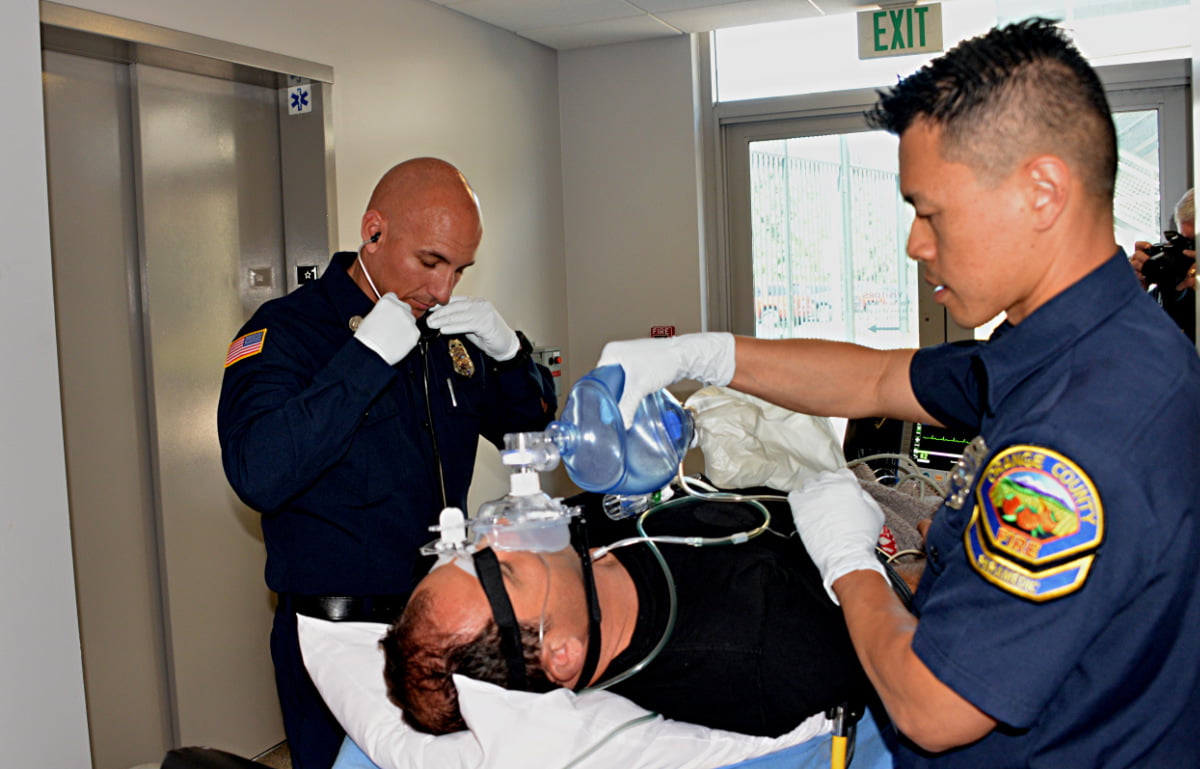
Photo/Rick McClure
Bag-mask ventilation (BVM) is the cornerstone for management of patient in need of supplemental ventilation in the prehospital setting. It is a skill learned by all EMS providers in early initial education, however, it is not a skill routinely practiced to the level where there is true proficiency by EMS providers. Supplemental ventilations can be delivered by bag-valve-mask ventilation or bag-valve-device (BVD) ventilation. While the skill is taught initially, the skill is challenging.
There are some recommendations from the NAEMSP published in Prehospital Emergency Care regarding this skillset that will be discussed in detail. The first recommendation is EMS providers must be proficient in bag-valve-mask ventilation. The second recommendation is BVM ventilation should be performed using a two-person technique whenever possible. The third recommendation is EMS providers should use available techniques and adjuncts to achieve an optimal mask seal, improve mask seal, improve airway patency, optimize delivery of the correct ventilation rate, correct tidal volume and pressure during manual ventilation and allow for continual assessment of manual ventilation effectiveness.
BVM is truly the fundamental skill of airway management. As an industry, EMS has come to rely heavily on the placement of endotracheal tubes or supraglottic airways. There are some patients these are very difficult to place in. In instances where placement of these advanced devices fails, the backup we are instructed to use is always BVM ventilation. With this method being the initial method of airway management, and the method we fall back to in the presence of failure of advanced devices, there is no surprise that the first recommendation is EMS providers must be proficient in BVM ventilation.
An effective mask seal is the crux of effective BVM ventilation. It has been proven that a two-hand mask seal technique is far superior to a one-hand technique. Historically, the E-C clamp method has been used, but the other two-handed thenar eminence technique is an alternative method. Modifying the typical E-C method to an E-O method may help achieve better ventilation. While certain methods may be more preferred than others, what matters is what EMS providers practice and are proficient in delivering the best possible care to the patient.
One of the reasons airway management is important is due to the decrease in muscle tone around the airway and the tongue in the patient who is completely unresponsive or have severe altered mental status. BVM ventilation in the patient is only part of what we need to do for them. The other equally important step is positioning of the airway. Placing the patient is a neutral, or sniffing position, coupled with a good mask seal will not only allow for good airway management, but also for ventilation management. Along with positioning, BLS adjuncts such as nasopharyngeal airway and oropharyngeal airway devices may be used.
Always ensure proper rate and volume of ventilation. It doesn’t matter if you’re providing BVM or BVD ventilations when it comes to managing rate and volume. In hospital-based environments, this is an easy task. In the prehospital environment, there are many more distractions that makes this much more difficult. Distractions in the field usually lead to the patient being hyperventilated. Regardless of the patient either being hyperventilated or hypoventilated, the outcome for the patient is usually poor. The American Heart Association (AHA) recommendations include a rate of 10 breaths per minute for an adult with a tidal volume of 500-600 ml. For pediatric patients, the recommendation is 20-30 breaths per minute with tidal volume recommendations based off the patient’s weight. The overall recommendation, regardless of age, is an emphasis to not excessively ventilate patients.
Timing and feedback devices have been shown to assist EMS providers in delivering appropriate rates and volumes when ventilating patients. The combination of visual prompts with real-time feedback showed the most improvement. Another issue from hyper or over inflation is gastric insufflation. This can be mitigated by using a pediatric sized BVM to ventilate adult patients. With the bag having a smaller volume and the EMS provider using less fingers to squeeze the bag, a more ideal volume being delivered to the patient is achieved.
What about pressure? With mask seal, airway management, appropriate rate and appropriate volume being discussed, pressure is the next important component. Using a BVM without any other devices typically allow for a higher peak inspiratory pressure (PIP) than what the patient needs. Decreasing the size of the bag or placing a manometer to limit pressure being delivered have been shown to lower the PIP being delivered to the patient to a more appropriate level. Positive-end expiratory pressure (PEEP) that is controlled can also be beneficial to the patient. It is known that excessive PEEP can cause an increase in intrathoracic pressure, however controlled PEEP shows more benefit than harm to patients.
With all these different facets of manual ventilation to take into consideration, the question is usually how to monitor it all. In the prehospital environment, methods and devices to achieve this are few and far in between. Pulse oximetry has been available in the EMS toolbox the longest, however changes in pulse oximetry based off a ventilatory change may take two minutes or longer to manifest in an SpO2 value. End-tidal CO2 with waveform capnography is the current best method for monitor ventilation. The upward amplitude on the capnograph will show the patient’s exhalation and the numeric value will indicate how well the patient is being perfused. Remember, this is not a silver bullet. Inadequate perfusion can make this value unreliable as well and an incomplete mask seal in patient’s receiving BVM ventilation.
As with anything else in medicine, including prehospital medicine, more research is indeed needed on this topic. The importance of appropriate documentation and collection of data points from patient care documentation assists in this research and furthers the understanding of how we can best serve our patients.
Jason Haag is the assistant chief of operations for Finger Lakes Ambulance and the owner of Medivation, LLC. He has more than 20 years of fire and EMS experience and management experience in EMS billing. He started as an EMT in 2003 and advanced to the paramedic level in 2006. In 2008, Jason studied at the University of Maryland Baltimore College to obtain a certification in critical care transport. Jason worked as a CCEMT-P since 2008 and has experience transporting critically ill patients utilizing ventilators, IV pumps, advanced pharmacology, and RSI. He was an EMS supervisor from 2010-2018. Jason successfully earned his CIC certification and teaches for many agencies across New York. He also speaks at conferences, hosts classes, and coordinates educational offerings. Jason continues his EMS advocacy through his active involvement with Finger Lakes Regional EMS Council, NY SEMSCO, Wayne County ALS, AHA instructing, NASEMSE and NAEMT. His involvement with Geneva Fire Department, Boy Scouts, Masons, Rotary, and Ducks Unlimited occupy his days after his daily family time with his wife Jami and son Gavin.


